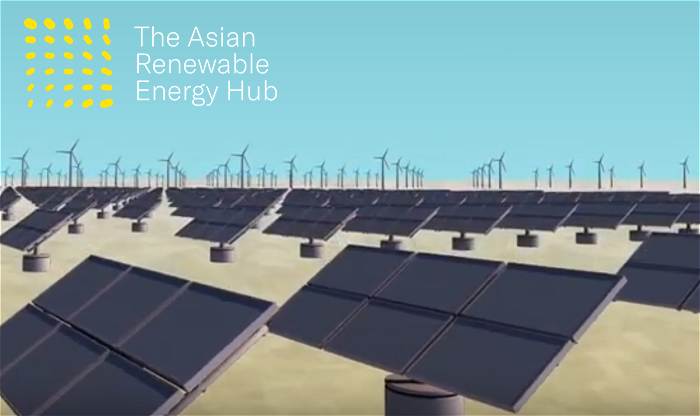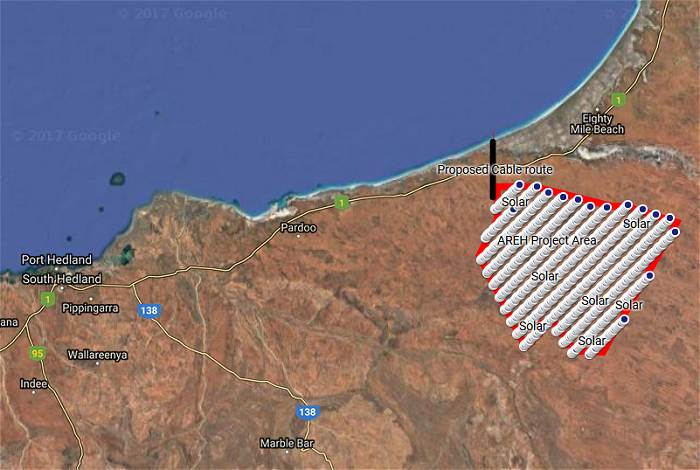
Image: Asian Renewable Energy Hub (AREH)
A consortium has announced a proposed wind and solar power plant of up to 6 gigawatts capacity in Western Australia’s East Pilbara region that will export electricity to Indonesia.
As we mentioned earlier today, demand for electricity in Indonesia is growing rapidly. The country has set a renewable energy target of 31% by 2050, but is challenged by a lack of suitable land on which to build clean power stations. This provides an opportunity for Australia in exporting electricity to the country, a scenario that has already been found to be feasible.
One of the largest renewable energy projects in the world, the Asian Renewable Energy Hub (AREH) consortium partners include CWP Energy Asia, Intercontinental Energy and wind power giant Vestas. The consortium has spent 3 years in developing the proposal and assessing its viability.
7,000 square kilometres of desert land in the East Pilbara region of Western Australia has been selected to host at least 4,000 MW of wind capacity (~1,200 Vestas wind turbines) and 2,000 MW of solar panels – 10 million modules. The consortium says it’s enough capacity to supply the equivalent of 7 million Indonesian homes.
The Asian Renewable Energy Hub will avoid more than one billion tonnes of carbon dioxide emissions over its lifespan.
The land has been secured through an Exclusive Development License with the WA Department of Lands and the project has the support of the region’s traditional owners, the Nyangumarta people.
Undersea High Voltage Direct Current (HVDC) cables, which enable the efficient transmission of electricity over long distances, will be run from a site near 80 Mile Beach and along the Maritime Silk Road to Java, Indonesia and Singapore.
The wind and solar components for the project will be manufactured in Indonesia, providing significant employment and investment in manufacturing facilities in that country. As to how many jobs would generated in Australia for the construction of the huge facility and other figures relating to local economic benefits haven’t been mentioned as yet.
“The Asian Renewable Energy Hub can compete over the long-term as a cost-effective means of supplying energy,” said Clive Turton, President of Vestas Asia Pacific. ” It can also provide the foundation for a strong Indonesian renewable energy technology manufacturing hub, driving investment, job creation and a local value-added supply chain.”
The first phase of the AREH Project has an initial cost estimate of USD $10 billion. Subsequent phases will see renewable energy being supplied to other South East Asian countries.
“By 2025, the AREH would provide reliable and cost-competitive electricity that would help to meet Indonesia’s energy demand and renewable energy targets.”
At this point, EIA referral documents have been submitted for the project. Assuming all approvals are gained, a final investment decision will be made in 2020, with construction slated to commence in 2020 and the project being fully operational in 2029.
More on the AREH project can be viewed here.


 RSS - Posts
RSS - Posts



And what a wonderful resource, such an enterprise would be, for transferring WA’s, and, the NT’s electricity grids, to clean, green, electricity generation.
(“We have the resources. We have the technology. We just lack the intelligence.”)
It could even lead WA to transformation from a bankrupt, third world, state, to being a world leader, like the (many years ago) proposed Ord River Pipeline, which could have provided clean water to the southern half of WA, and, led to development and advancement of WA, but, it was regarded as being too advanced for a backward, backwater state like WA, especially, with the suggested means of powering required pumping stations, with the unrealistic and fantasy world concept of solar power (and, yes, it WAS suggested,. many years ago, but, the state parliament, as always, refused to remove its blindfold).